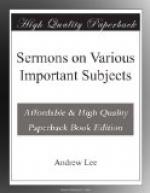To this agree the other prophets who treat of this subject. No other limits the term of Christ’s reign; or mentions Satan’s being enlarged and permitted any measure of deceptive influence, after the restraints laid upon him at the beginning Christ’s reign. But others foretell the happy day, and several seem to dwell delightfully upon it, and represent it as continuing to the end of time; and none give the remotest hint that it is to terminate, and iniquity again to become universally prevalent.
Isaiah often mentions it, and dilates more largely upon it than any other who lived before the gospel day. From his representations we should expect it to terminate only with time. “I will make the an eternal excellency—violence shall no more be heard in thy land; wasting nor destruction within thy borders—the sun shall be no more thy light by day; neither for brightness shall the moon give light unto thee, but the Lord shall be unto thee an everlasting light, and thy God thy glory—the days of thy mourning shall be ended—thy people shall be all righteous; they shall inherit the land forever.”
By the little horn in Daniel’s vision, Antichrist is doubtless intended. When at his fall Christ is to take the kingdom; or it is to be given to his people, it is to be an abiding kingdom. “And there was given unto him dominion, and glory, and a kingdom, that all people, nations and languages, should serve him; his dominion is an everlasting dominion, which shall not pass away, an his kingdom that which shall not be destroyed.”
This is a prophecy of the universal prevalence of true religion in the last days, after the reign of Antichrist shall have come to an end. By the explanation in the latter part of the chapter, the saints are from that period to have the dominion. It is no more to be taken from them. “The saints of the most high shall take the kingdom, and possess the kingdom for ever, even forever and ever—and the kingdom and dominion, and the greatness of the kingdom under the whole heaven, shall be given to the people of the saints of the most high, whose kingdom is an ever lasting kingdom, and all dominion shall serve and obey him.”
These representations agree with that made to St. John, who saw the church guarded and protected from infernal power and influence, at the close of the millennium. The only difference consists in the mention of a few particulars by the apostle, which were not communicated to the prophets; such as the term of Christ’s reign on earth; and some fruitless attempts of the powers of darkness against his people, after that term shall have expired.
The coming to judgment cannot therefore be intended in the text. There will then be faith on the earth. But if we consider “that which is noted in the scripture of truth,” respecting the moral state of the world before and at the time of Christ’s coming to reign upon it, we shall find it answering to this description.




